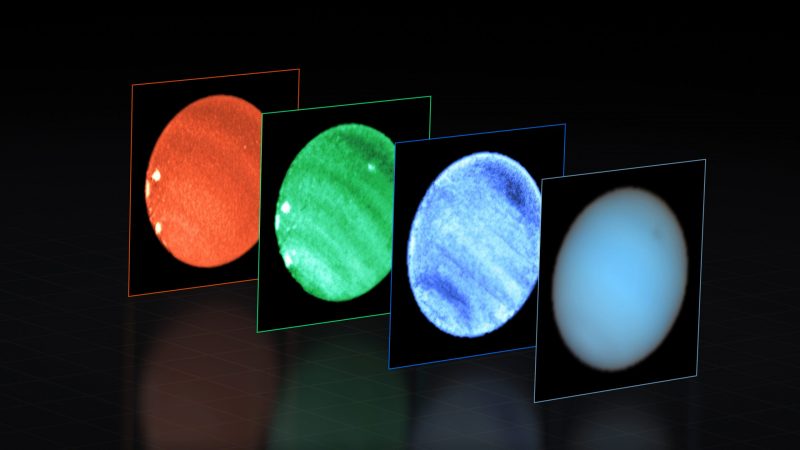Scientists at the European Southern Observatory (ESO) said today (August 24, 2023), that they’ve now caught sight of a new mysterious dark spot on Neptune, the 8th planet from the sun in our solar system. Plus it has an unexpected smaller bright spot adjacent to it. And they didn’t have to send up a spacecraft – or a space telescope – to see these spots on Neptune.
The most famous Neptune dark spot was spotted by the Voyager 2 spacecraft, during its historic sweep past Neptune in 1989. Neptune’s Great Dark Spot, as it was called, lasted only about two years. That’s in contrast to Jupiter’s Great Red Spot, which we’ve seen for centuries.
And, also unlike the Red Spot, scientists thought Neptune’s Dark Spot center was largely cloud-free. But the new observations – from the scientists at ESO – suggest that’s not the case.
Patrick Irwin, professor at the University of Oxford, led the discovery team. They used ESO’s Very Large Telescope (VLT) in Chile to observe Neptune. That makes these new Neptune spots the first to be confirmed from Earth. Irwin shared his excitement, saying:
Since the first discovery of a dark spot, I’ve always wondered what these short-lived and elusive dark features are.
Irwin and team published the results of their study in the peer-reviewed journal Nature Astronomy on August 24, 2023.
Mysterious Neptune dark spot
So are these dark spots on Neptune really a clearing of clouds? Not according to the data from the VLT. As the astronomers’ statement said:
The new observations indicate instead that dark spots are likely the result of air particles darkening in a layer below the main visible haze layer, as ices and hazes mix in Neptune’s atmosphere.
Astronomers took the first step toward this solution in 2018, when the Hubble Space Telescope spotted dark spots on Neptune, including on in the northern hemisphere. Irwin and team then used the VLT’s Multi Unit Spectroscopic Explorer (MUSE) to take a closer look.
With MUSE, the team was able to look at the spectrum, or a more complete look at the wavelengths of light from Neptune. As Irwin said:
I’m absolutely thrilled to have been able to not only make the first detection of a dark spot from the ground, but also record for the very first time a reflection spectrum of such a feature.
Looking at the spectrum allowed the astronomers to where, in the depths of Neptune’s atmosphere, the dark spot resided. The information from the spectrum also gave astronomers the chemical composition of the different layers of the atmosphere. And this, in turn, helped them understand why the spot is dark.
A closer look at Neptune’s dark spot

A bright white spot
Along with observations of the dark spot, astronomers also found a bright white spot nearby in 831 nm (green) image. This reveals a deep level of atmosphere on Neptune, at the same level as the dark spot. Therefore, it’s different from the companion high-altitude clouds of methane ice that previous images found. Co-author Michael Wong, of the University of California, Berkeley, talked about the team’s ability to find this bright cloud using instruments on Earth:
In the process we discovered a rare deep bright cloud type that had never been identified before, even from space.
This is an astounding increase in humanity’s ability to observe the cosmos. At first, we could only detect these spots by sending a spacecraft there, like Voyager. Then we gained the ability to make them out remotely with Hubble. Finally, technology has advanced to enable this from the ground.
Then, Wong joked:
This could put me out of work as a Hubble observer!
Bottom line: Astronomers have spotted a dark spot on Neptune from Earth-based observatories. Viewing its spectrum, the discovered that it’s air particles darkening in a layer below the main visible haze layer. Nearby, the also spotted a bright white spot.
Source: Cloud Structure of Dark Spots and Storms in Neptune’s Atmosphere
Read more: Neptune’s disappearing clouds linked to solar cycle
The post Mystery of Neptune dark spot solved. New white spot found first appeared on EarthSky.
0 Commentaires